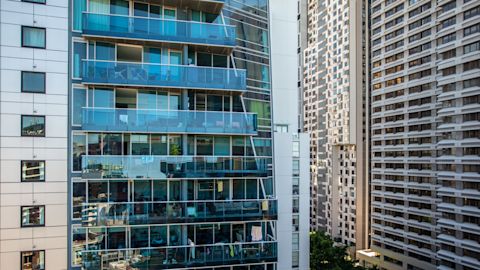New buildings will use more renewable energy and support the transition to net-zero emissions under our Australia-first plans to include energy targets in development applications.
The City of Sydney’s plans were unanimously endorsed by Council at its August meeting.
Development applications for new office buildings, hotels and shopping centres and major redevelopments of existing buildings will comply with minimum energy ratings from January 2023 and achieve net-zero energy use from 2026.

The new planning rules combine energy efficiency and the use of onsite and offsite renewables to move buildings towards net zero energy use. Including the option to use offsite renewable energy purchases is another first for local planning rules in Australia.
The performance standards and evidence base can be used by all councils across Greater Sydney and will support investment in renewable energy and create jobs in regional areas.
We’ve already invested in wind and solar farms in Inverell, Nowra and Wagga to help us achieve 100% renewable electricity from locally sourced clean energy.
The new planning measures are expected to save more than $1.3 billion on energy bills for investors, businesses and occupants from 2023 to 2040, and help us meet its target of net-zero emissions by 2035.
Lord Mayor Clover Moore said energy use in buildings was a significant contributor to greenhouse gas emissions.
“Commercial office space, hotels and apartment buildings contribute 68% of total emissions in the City of Sydney. If we’re to meet our target of net-zero emissions by 2035, we need the building sector to play its part,” the Lord Mayor said.
“These new controls, four years in the making, require developers to reduce emissions through increased energy efficiency, on-site renewable energy production and offsite renewable energy procurement. They are ambitious but achievable and provide a clear pathway for developers to improve energy performance and transition to net zero buildings.”
“Working with our major developers and building owners to address the climate crisis could not be more important. Not only will this program help us reach our target of net-zero emissions by 2035, it will provide energy savings of more than $1.3 billion for investors, businesses and occupants across Greater Sydney.”
Final amendments were made to the proposal after the City of Sydney reviewed feedback during the public exhibition late last year.
The amendments provide more clarity for developers in the structure and operation of the controls, particularly for projects involving the refurbishment of existing buildings. The amendments also make it easier for existing buildings to demonstrate how they are moving towards net-zero emissions.
Neil Arckless, Lendlease executive development director, said his organisation supported the ambitious performance standards.
“At Lendlease we recently set our own pathway to net zero carbon by 2025 and absolute zero by 2040,” Arckless said.
“We’re always pushing the boundaries to innovate in sustainability and welcome the City of Sydney leading the way in the development of these performance standards. I’m confident we can all rise to the challenge."
Façade remediation of the stonework, steel and bronze window repairs and façade lighting for the George and Barrack streets frontages will follow.

Stockland CEO Commercial Property Louise Mason said the company strongly endorsed the City of Sydney’s net-zero energy buildings performance standards.
“We've brought forward our target to achieve net zero carbon emissions to 2028 and extended the commitment across our entire portfolio, covering close to 170 active assets and projects Australia-wide,” Mason said.
The measures are expected to deliver substantial financial benefits. Annually office owners will save $2,750 per 1,000 square metres of floor area and hotel owners $170 per hotel room.
There are projected public benefits and savings in health, energy network and emissions costs, worth around $1.8 billion. The planning controls also support the NSW Government's renewable energy zones through investment and create demand for jobs and new skills in energy efficiency.
The performance standards address requirements in the Greater Sydney region plan and respond to local, state and industry goals, including the NSW net zero plan and electricity strategy, district plans to reduce carbon emissions and sustainability actions in local planning.
Read more about the net zero proposal.
Published 23 August 2022, updated 13 October 2023



